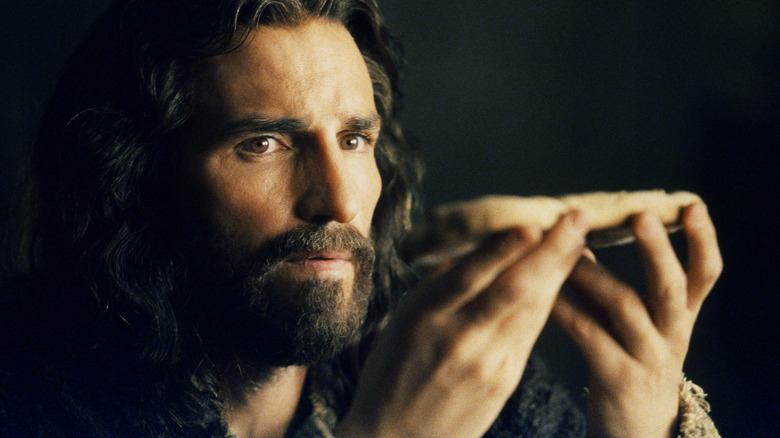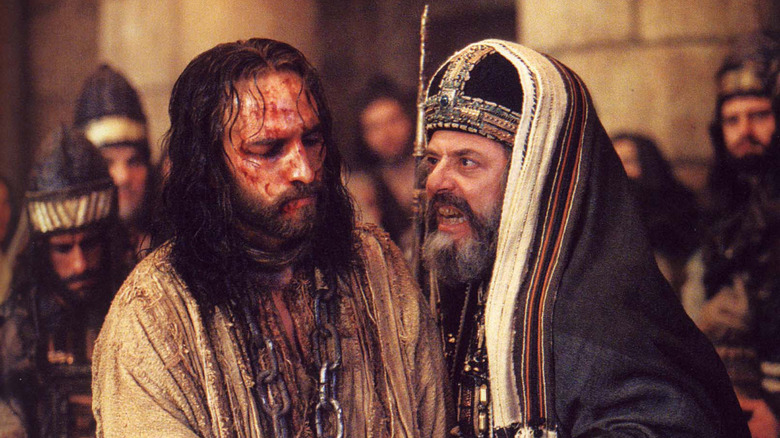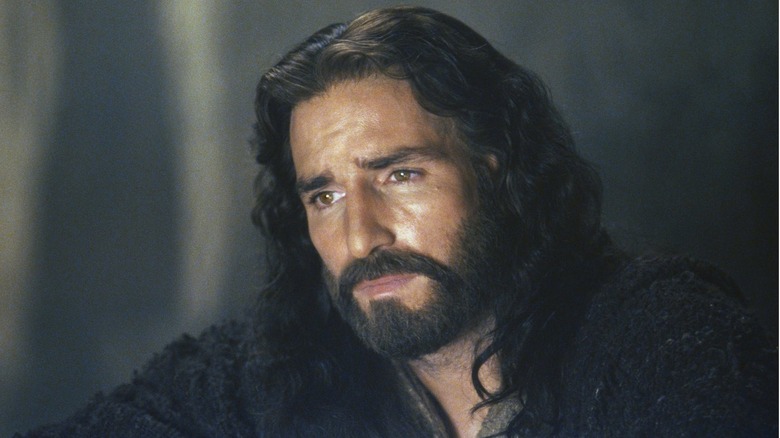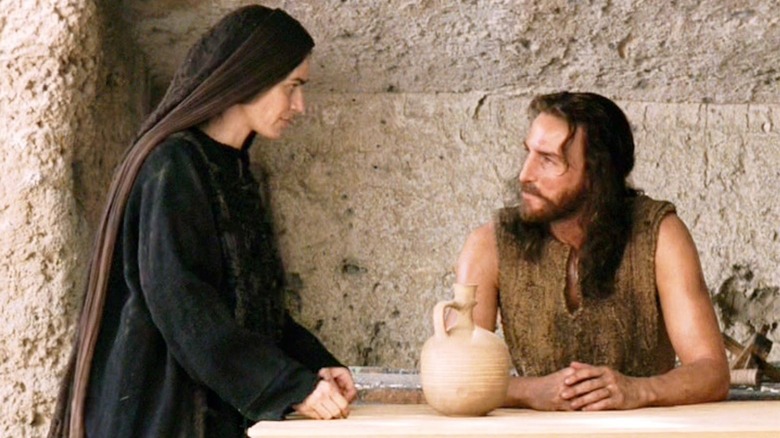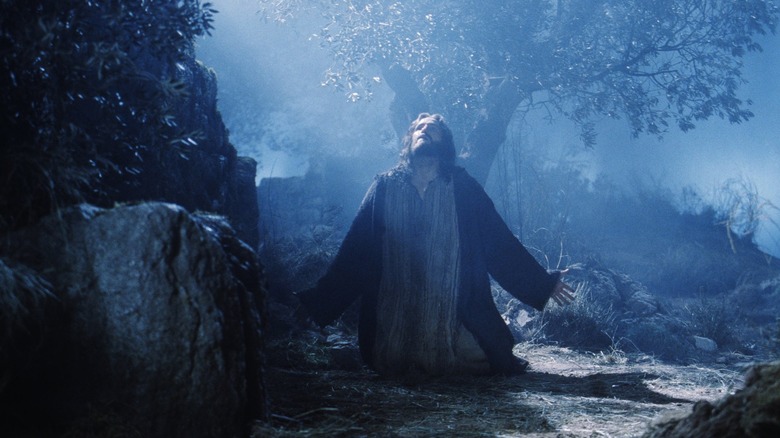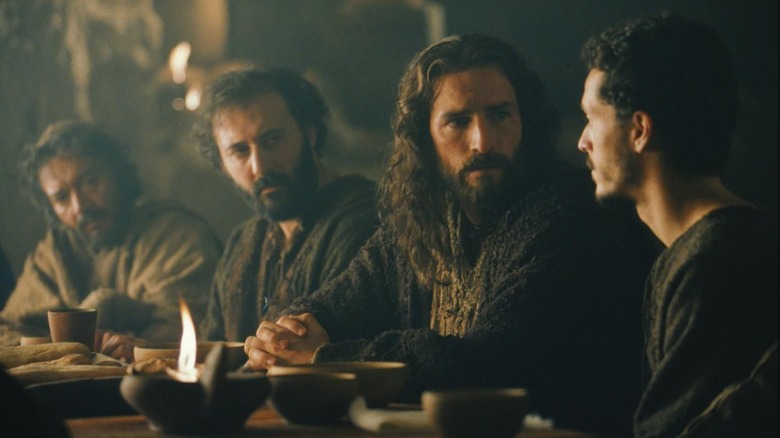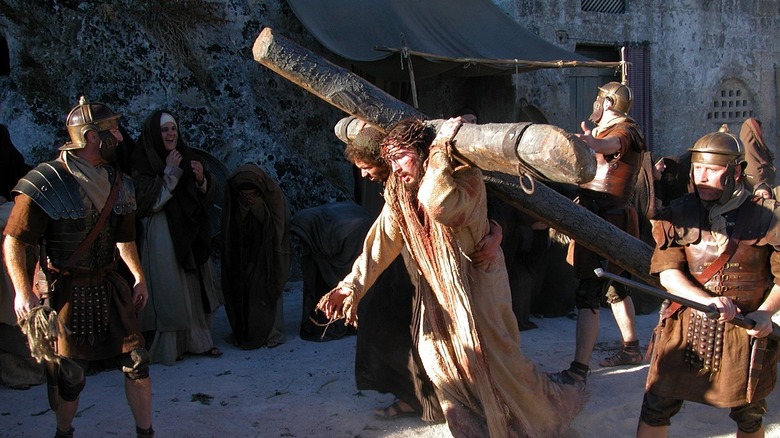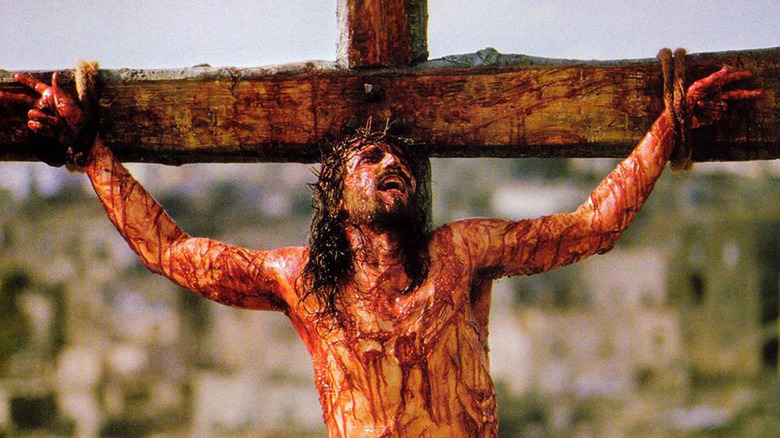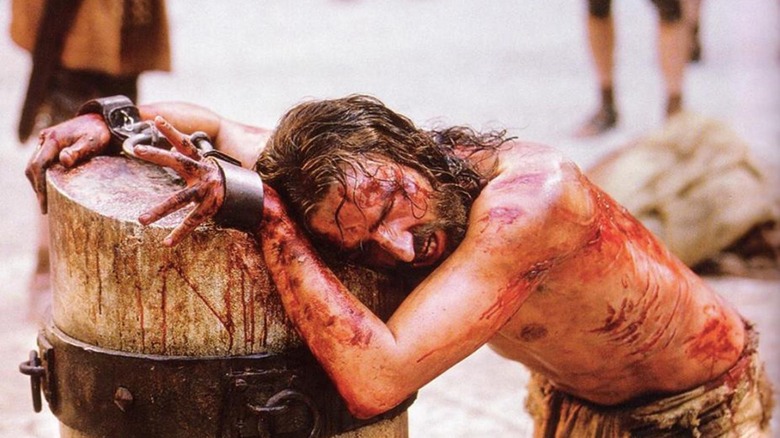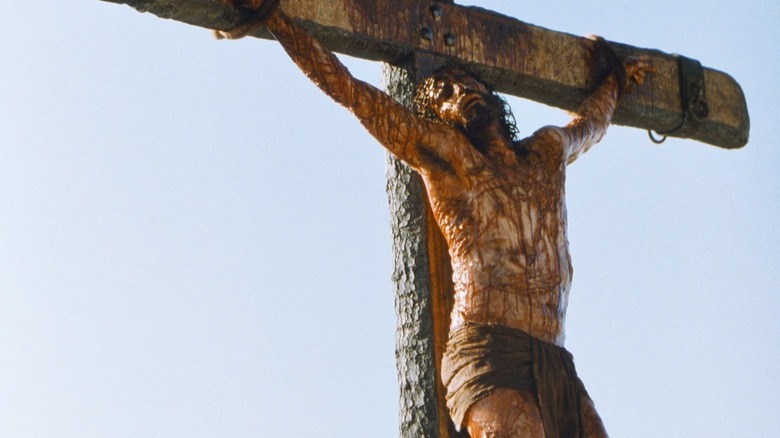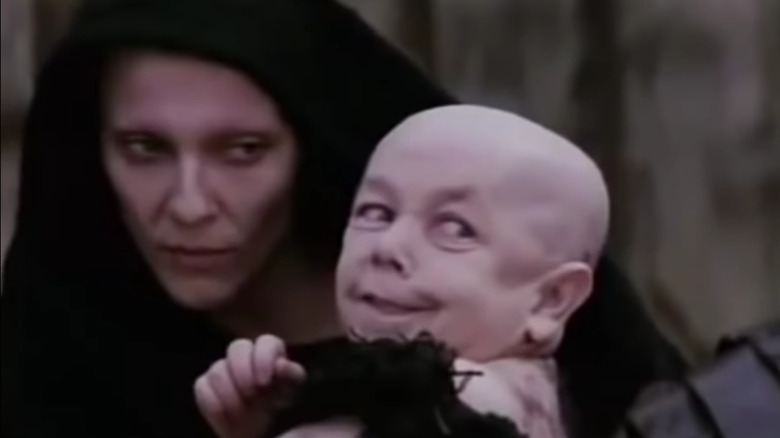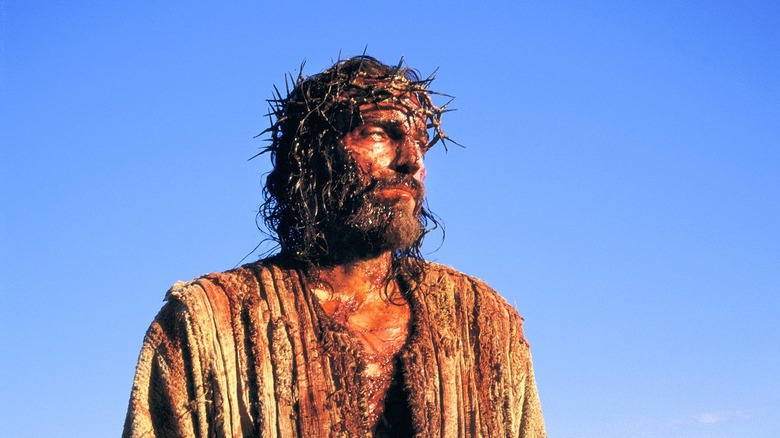What The Passion Of The Christ Gets Wrong About Jesus
Regardless of whether you're a true believer or a committed atheist, Mel Gibson's "The Passion of the Christ" is a hard watch. Watching any man, let alone the Son of God mocked, beaten, and whipped for the best part of two hours and seven minutes is an uncomfortable experience. Christ's final agonies are documented in what The Guardian described as, "an incredibly obtuse piece of macho-masochism, overlooking Jesus's message of love and his human complexity." Roger Ebert described it as "the most violent film I have ever seen." Yet he did point out that as a devoted Catholic, Gibson's primary motive was to leave viewers with no choice but to confront the true and very graphic price Christ paid for our sins. Even so, many audiences found the movie and its message powerful and uplifting.
Any portrayal of Jesus Christ, particularly on the big screen, is always going to be open to criticism, or even worse, accusations of blasphemy. Gibson's Christ in particular seems defined by his suffering and his pain. Yet when you wipe away the blood and scars that cover Jesus's body from top to bottom like a victim in the goriest slasher movie, what remains? A historically accurate depiction of Christ according to the gospels? Or merely one that is formed from a subjective projection of Gibson's own religious beliefs? Let's pick up the cross and find out for ourselves.
Jesus was Jewish
Mel Gibson has a long history of anti-Semitic behavior, both confirmed and alleged (via the Forward). In 2006, his career came off the rails after he drunkenly berated Jewish police officer James Mee on camera. Gibson can be cursing and saying "The Jews are responsible for all the wars in the world." Gibson later apologized for his conduct. However, Gibson continued to be plagued by accusation of anti-Semitism.
In an interview with The Sunday Times in 2020, Winona Ryder repeated the allegation that Gibson once asked her if she was an "oven dodger" at a party in 1996. Although a representative for Gibson strongly refuted such allegations (via The Hollywood Reporter), and Gibson has called anti-Semitism a sin that "goes against my faith," the anti-Semite label has stuck. Writing in The Atlantic, actor Joshua Malina labeled Gibson a "well-known Jew-hater," and believes "The Passion of the Christ" rehashes and strengthens the portrayal of Jews as willing Christ-killers. The Los Angeles Times reports the depiction of hooded Jews rejoicing at the torture of Jesus in "The Passion of the Christ" angered some Jewish leaders, who described the movie as "unhealthy for Jews all over the world."
Yet what Gibson's film fails to make apparent was that Jesus was born a Jew and died a Jew. According to Frontline, even the most casual reader of the Gospels can see that Christ was a Jew who celebrated Jewish festivals, preached from Jewish text, and simply disagreed with other members of the Jewish faith on certain things. "The Passion of the Christ" is often guilty of portraying Jews as almost alien life-forms to Jesus. When asked on Primetime if the Jews were responsible for killing Jesus, Gibson replied, "Jesus was a child of Israel, among other children of Israel. There were Jews and Romans in Israel. There were no Norwegians there. The Jewish Sanhedrin, and those who they held sway over — and the Romans — were the material agents of his demise."
Jesus didn't have long hair
It doesn't matter if it's Jesus on a postcard, Jesus on a cross, or Jesus on a t-shirt, nearly every physical representation of the Almighty's only child has him rocking the long hair and bearded look. Some depictions of Christ make him look like a hippy, whilst others make him appear more of a tortured guru prone to debilitating bouts of existential despair. In "The Passion of the Christ," Jim Caviezel doesn't deviate from the time-honored image. Yet here's the rub: those long flowing locks and bushy beard are not historically accurate.
According to Christianity.com, the Bible doesn't contain any passages where it describes the length of Jesus's hair. However, some verses go into detail about how Jewish men wore their hair according to biblical law. It's likely Jesus has a short back and sides, long sideburns (called payot), and a neatly trimmed beard.
The Apostle Paul wrote 50 years after Christ's birth, "Does not nature itself teach you that if a man wears long hair it is a disgrace for him?" Jesus once said, "So you also appear righteous to others, but within you are full of hypocrisy and lawlessness." (Matthew 23:28) So he might have grown his hair out as an act of rebellion against the establishment, but it's more likely the traditional image we have of him, including the one in "The Passion of the Christ," is wrong and based on a Medieval interpretation.
Jesus didn't invent the dining table
There's a scene in "The Passion of the Christ" that shows Jesus laboring away lovingly with some wood in his backyard. His mother Mary comments that it's a tall table her child is working on. She asks who it is for, and Jesus replies, "A rich man." To which she jokes, "Does he prefer to eat standing up?" Jesus reveals he is working on a tall table for tall chairs. Mary tries it out before giving her judgment that, "This will never catch on," as Christ looks on fondly, no doubt visualizing all the Christmas dinners that will be held around such a table. Although the scene appears to imply that Jesus invented the modern dining table and chairs, there's one small catch — he didn't!
Even those who have never picked up a copy of the New Testament will tell you Jesus was a carpenter by trade. Yet he didn't invent the dining table. In fact, he may not have even been a carpenter. According to Christianity.com, Gospel scripture hails Jesus as the "carpenter's son," suggesting he picked up the trade from his father. Yet the word "carpenter," translated from the Greek word "tekton" could also mean builder, laborer, or a general handyman good at fixing or building things. There is a suggestion that Jesus was a stonemason. The Hebraic scholar James W. Fleming notes that the majority of Israel's homes are made from stone and the lack of trees in Jesus's native region would render the role of wood carpenter extremely rare.
Jesus wasn't tempted by Satan in the garden of Gethsemane
There's a creepy character in "The Passion of the Christ" who isn't lurks around the place with evil intent, and who adopts a most peculiar and unnerving voice. Played in a haunting and androgynous fashion by Rosalinda Celentano, The Prince of Darkness, the Father of Lies, or to those who knew him before the fall, Lucifer Morningstar pops up in random places during the film. Satan, as he's known by the hordes of hell, makes a spectacular and quite dramatic appearance when tempting Christ in Gethsemane. Only trouble is, in the Bible, it doesn't quite pan out like that. In fact, it doesn't happen at all.
Jesus retreated to the garden of Gethsemane after the Last Supper with his disciples Peter, James, and John to pray. He was aware of the agonies that awaited him and asked for his father's strength to endure the coming trials and tribulations (via Bible Study Tools). The Gospels acknowledge that "He fell with his face to the ground" (Matthew 26:39) and cried out, "My soul is overwhelmed with sorrow to the point of death (Mark 14:34), and begged his father to "Take this cup from me." (Mark 14:36). Yet at no point does it indicate he was tempted by the Devil.
According to Mel Gibson, his use of Satan in Gethsemane is to highlight the alluring nature of evil. Gibson explained to Christianity Today that "I believe the Devil is real, but I don't believe he shows up too often with horns and smoke and a forked tail."
Jesus wasn't fluent in Latin
Jesus may have walked on water, turned water into wine, brought hearing to the deaf, and restored eyesight to the blind, but it's highly doubtful he was fluent in Latin as depicted in "The Passion of the Christ." History.com reports that, as a first century A.D. man living in the kingdom of Judea, there has been considerable debate about what language Jesus spoke. During a 2014 conversation in Jerusalem between Israel prime minister Benjamin Netanyahu and Pope Francis, Netanyahu explained, "Jesus was here, in this land. He spoke Hebrew." To which the Pope replied, "Aramaic." In response to the Pope's correction, Netanyahu said, "He spoke Aramaic, but he knew Hebrew."
The linguistic locking of horns made headlines across the world. However, most religious historians believe Jesus was multilingual, who spoke a Galilean dialect of Aramaic in his everyday life but also was well versed in Hebrew. According to Oxford University's Jonathan Katz (via BBC News), other than a few basic words, Jesus would probably have been unable to speak Latin. The language was usually the sole preserve of the lawmakers and Roman military. In "The Passion of the Christ," Jesus and his disciples mainly converse in Old Aramaic, with Hebrew being the language of the Jewish authorities. The exception is the scenes with Pontius Pilate. The Roman addresses Jesus in Aramaic, but to prove his linguistic prowess and to demonstrate he will not be bowed, Jesus answers him in fluent Latin. It's a dramatic moment and not unlike when Mel Gibson's character William Wallace switches to Latin in "Braveheart." Yet although the Scottish freedom fighter may have been fluent in Latin, Jesus was not.
Jesus wasn't forced to carry the entire cross
In "The Passion of the Christ," the scene where Jesus is seen struggling under the weight of his cross is particularly harrowing. Bruised, battered, wearing a crown of thorns and being whipped mercilessly by sneering Roman soldiers, he staggers on, exhausted and abandoned, to his execution. The crucifixion is an integral part of Christ's story. All roads lead to the cross and it's a burden that he alone had to carry — but not literally. Mel Gibson shows Simon of Cyrene being forced by the Romans to help Jesus carry his cross, reluctantly at first but then with compassion, neither man would have had to carry its full weight.
The Romans delighted in torturing and humiliating slaves and rebels by forcing them to carry the instrument they would suffer a painfully long death upon. Yet according to Imperium Romanum, these poor individuals would only carry the cross's horizontal beam (patibulum). Seneca the Younger used the phrase infelix lignum (unfortunate wood) to describe the horizontal beam of the cross poor unfortunates such as Jesus would have been forced to carry. Roman source literature describes how victims were often scourged and experienced significant blood loss before being made to carry the weight of their patibulum. The vertical beam (stipes) would already have been erected in the ground and awaiting the horizontal beam. It's extremely unlikely that Jesus's path to Golgotha involved him carrying the entire cross.
Jesus was probably tied and not nailed to the cross
It doesn't matter if the individual was tied or nailed to the cross, crucifixion was an agonizing and terrible death. A person could bleed out on the cross, die of dehydration, or for those whose legs were broken, simply choke to death as their own body weight crushed their diaphragm. Either way, it could last for a few hours, or for the truly unfortunate, days. In 337 AD, Emperor Constantine the Great banned crucifixion in Rome to honor its most famous victim — Jesus Christ. According to the Gospel of Mark, Jesus was hung on the cross in the morning. "They brought Jesus to the place called Golgotha. It was nine in the morning when they crucified him." (Mark 15:22-25). The Gospel of Luke reveals that Jesus passed at about three in the afternoon.
In total, Jesus spent about six hours on the cross. Yet The Independent reports that in all the New Testament Gospels, there is no mention of him being nailed to it. Archaeologists Dr. Andrea Berlin and Dr. Jodi Magness both stress that most people who were crucified were tied to the cross. In cases where they were nailed, the nails were hammered through the wrists as opposed to the palms. In "The Passion of the Christ," the nail is clearly shown being hammered into the palm of Christ, by the hand of none other than Mel Gibson himself (via Today). It was a symbolic gesture expressing the director's accountability for Christ's death. It just may not have been all that historically inaccurate.
Jesus wasn't tortured in such a sadistic fashion
"The Passion of the Christ" has been branded as unnecessarily bloodthirsty. It's almost like Mel Gibson decided to take the final scene of "Braveheart" where William Wallace was hung, drawn, and quartered, and extend it for over two hours of gratuitous horror. When Pontius Pilate tells him men to ensure the punishment of Jesus is severe but to stop short of killing him, it's open season for a catalog of sadistic horrors. The Guardian describes what follows as filmed in "unflinching — it's tempting to say psychotic focus." Although any person condemned to crucifixion was heading for a world of pain, there's no evidence in the gospels that Jesus was tortured in such a barbaric manner.
Matthew, Mark, and John all describe how Jesus was "flogged" but make only a passing reference to it, preferring to focus instead on their messiah's love, life, and teachings. The mutilations inflicted upon Christ in the movie are grotesque as they are inventive, and the torture is seemingly neverending. The question is, why? The Society for U.S. Intellectual History explains, "It feels as if Gibson is attempting to torture viewers into belief, or redemption, through a pornography of suffering." They add that they believe Gibson focused on Christ's physical suffering at the expense of the spiritual suffering documented in the Bible, and state, "It's as if God chose to make a spectacle of the human body to underscore an inhuman, godly ability to absorb punishment. In Gibson's hands, God becomes a superhero."
Jesus's loincloth is historically inaccurate
The Jesus in "The Passion of the Christ" suffers indignity after crushing indignity at the hands of his snarling and sadistic tormentors. By the time he is nailed to the cross and hung before a watching world, he is bloodied, bruised, and broken and his face is almost unrecognizable, yet at least he remains partially clothed thanks to the stained and ragged loincloth. Unfortunately, Jesus's modesty would not have been a concern of the Romans. Archaeologists Dr. Andrea Berlin and Dr. Jodi Magness emphasize, "For this film to be an accurate depiction of Christ's crucifixion, it would have to be rated X." That's because Christ would have been completely naked when hanging on the cross. They explained that both men and women in Christ's time wore tunics, belted at the waist, with no underwear.
Being hung on a cross to die was as much about humiliation as it was harm. The degradation and pubic shame of their victim was an important element of crucifixion for the Romans. There were simpler means of execution, but none quite so obscene and horrific. According to the Gospel of John, Jesus was crucified naked, in front of his mother and friends at Golgotha. Historians believe the site of Christ's execution was the then-equivalent of a busy downtown intersection. The Romans believed that shaming their victims in such strategic spots would act as a deterrent to all those who would defy the rule of Rome.
Jesus wasn't taunted by a leering demon baby
One of the most sinister scenes in "The Passion of the Christ" doesn't involve any bloodshed or physical suffering whatsoever, but opts for the more powerful and time-honored trick of playing with our imaginations. It comes in the shape of a grotesque-looking baby, who is maggot white and has the leering face of a nasty old man with nothing but spite and venom in his eyes. We first catch glimpse of the demonic spawn being carried lovingly by Lucifer, when Jesus is being flayed and flogged by his enthusiastic tormenters. Satan strides purposefully through the watching crowd of gleeful priests and impassive Romans cradling his little bundle of joy. For a split second, the baby turns his head to look at Jesus and mocks him with an expression that speaks a thousand words.
It's a powerful scene, but there's no record whatsoever of it happening, Yet to his credit, Mel Gibson explained to Christianity Today that it was pretty much introduced for dramatic punch. He explained, "It's evil distorting what is good. What is more tender and beautiful than a mother and a child? So the Devil takes that and distorts it just a little bit. Instead of a normal mother and child, you have an androgynous figure holding a 40-year-old baby with hair on his back. It is weird, it is shocking, it's almost too much."
Jesus's existence wasn't defined by suffering
The life of Jesus in "The Passion of the Christ" is one of suffering and pain. He is not the beacon of love, truth, and forgiveness, but the martyred and crucified Son of God who atones for mankind's sins in a purely physical fashion. There is not much hope in Mel Gibson's film but plenty of despair. Perhaps the director plans to feature the more spiritual and redemptive qualities of Jesus's life in his long-anticipated sequel, "Passion of the Christ: Resurrection." As it stands, "The Passion of the Christ" takes the suffering element of Jesus's tales to new heights, or the lowest lows, depending on your point of view. Mel Gibson told ABC News, "Pain is the precursor of change, which is great." Yet just how much pain can a viewer stomach before they become desensitized to a film's message?
In the Gospels, the primary focus on Christ is as a teacher and not a martyr. He was someone who believed in a better world and wasn't defined by his suffering. Gibson insists Christ "was beaten for our iniquities," before adding, "He was wounded for our transgressions and by his wounds, we are healed. That's the point of the film." Gibson also explained that the film was his version of the gospels and that he wanted it to be extreme and force the viewer to appreciate the enormity of Christ's sacrifice. "I wanted it to be shocking," he explained.
